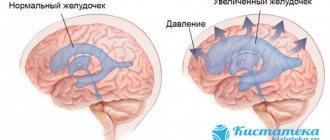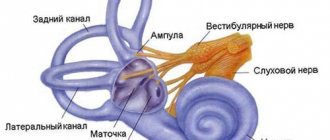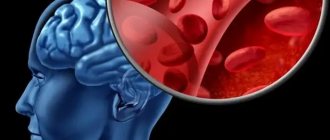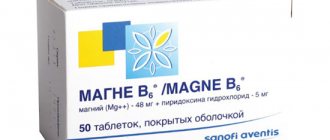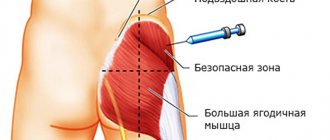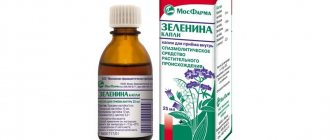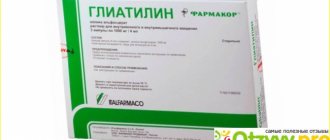Hydrocephalus of the brain treatment with folk remedies – Neurology
Hydrocephalus is popularly called dropsy of the brain.
This is a very terrible and serious disease that requires immediate intervention. Hydrocephalus
What kind of disease is this and why is it dangerous?
Hydrocephalus is characterized by a large, excess accumulation of fluid in the brain cavity. This disease is divided into 2 types:
- congenital;
- acquired.
Hydrocephalus is characterized by a large, excess accumulation of fluid in the brain cavity
Let's start with congenital. It develops from the very birth of a person who will certainly have problems with speech, mental disorders, problems with visual impairment, and headaches.
Congenital hydrocephalus
Acquired hydrocephalus can occur due to brain injury that a person may have suffered without being careful.
Symptoms
- To understand that a disease has settled in your body, you need to know its symptoms.
- Firstly, it is a severe headache of various types: it can be pulsating, increase from irritants, bright light, TV screen, temperature and occurs very often.
- Secondly, nausea appears, and thirdly, an increase in intracranial pressure.
In order to somehow help yourself, you need to take glycerin or similar drugs to lower your blood pressure.
If you suddenly notice these symptoms, immediately consult a doctor so that treatment can be received in a timely manner.
These are the main symptoms, but there are others that appear at a later stage, for example, speech inhibition, concentration and concentration begin to be absent, convulsions may appear, breathing is impaired, and most importantly, the size of the head increases.
Important! If you receive a head injury, do not wait for symptoms, but immediately consult a doctor and get examined, this will prevent the appearance and development of the disease.
After consulting a doctor, treatment begins by removing excess fluid to reduce intracranial pressure. In the future, surgical intervention is possible. After the operation, it is necessary to be observed by a neurologist.
Treatment of hydrocephalus with common folk remedies
Hydrocephalus can be cured with folk remedies, which, according to many, are no less effective than treatment in a hospital.
Melissa
Melissa
The most common method of treatment in traditional medicine is lemon balm decoction. It is usually used to normalize the functioning of the nervous system and get rid of severe headaches.
It is necessary to prepare a decoction, which will then need to be taken over a long period of time. Take lemon balm leaves - 15 grams, pour 200 ml of boiling water and wait until the liquid cools. This infusion must be taken exactly three times a day and strictly one tablespoon at a time.
Another option for this infusion is an alcohol tincture. Increase the amount of lemon balm to 25 grams, and you also need 200 ml of alcohol. Pour in the leaves and leave for 2 weeks in a cool, dark place. This decoction is also taken 3 times a day, but the dosage should be reduced to 15 drops (consumed before meals).
Cornflower tincture
The following traditional medicine recipe has a diuretic effect, which allows you to remove excess fluid from a sick body.
Cornflower tincture
This decoction has proven itself to be an effective way to treat hydrocephalus. It's very easy and quick to make. We will need 1 tablespoon of cornflower flowers and a large glass of boiled water.
Fill the flowers with water and leave for 2 hours. This time is enough for the product to infuse and become ready for use.
The finished medicine will need to be drunk 50 ml three times a day a quarter of an hour before eating.
Swamp calamus
Swamp calamus
A decoction from the stated plant will help strengthen the entire body, and in particular help in the treatment of hydrocephalus, and will also increase urination.
To prepare the medicine, we need to take calamus root in a size of fifty grams, be sure to peel it and pour in 0.5 liters of vodka.
This mixture needs time to brew, so leave it for 20 days in a cool, dark place. After the time has elapsed, the drug will be ready for use.
Half an hour before meals, drink a teaspoon of medicine. If you don’t have time to wait for the solution to infuse, you can use the calamus recipe in boiling water instead of alcohol. To do this, pour 15 grams of calamus into 600 ml of boiling water and wait 20 minutes. The mixture is ready, take it in the same way as the first option.
Astragalus
Astragalus
With the help of astragalus, not only hydrocephalus is treated, but also many other, no less complex diseases.
The decoction for the disease we are interested in is prepared as follows: you need to pour 200 ml of boiling water into 1 tablespoon of the plant.
So that the broth can brew, leave it for several hours and be sure to cover with a lid. You need to take the prepared medicine about 30 minutes before meals, 1 tablespoon 3 times a day.
Less common folk remedies
These were the basic and common recipes for decoctions for treating hydrocephalus at home. But there are also options that are less popular, but also have a place in folk medicine. One such recipe is black elderberry infusion.
Black elderberry
Black elderberry
This treatment option is suitable for the earliest stage of the disease. We will need the root of the plant directly. We fill it with alcohol so that the proportion is 1 to 10, respectively, per 100 grams of peeled root you need 1 liter of alcohol. This mixture should be infused for no more than 1 week. The finished medicine is taken orally 3 times a day in the amount of 25 drops.
Radish with garlic
The simplest and at the same time effective way to combat hydrocephalus. Together, these vegetables will also help in the treatment of this disease. We will need garlic and radish juice.
Squeeze the vegetables, mix the resulting juice so that the proportion is 1 to 1. There is no need to adjust the solution, consume immediately after preparation, 1 teaspoon three times a day.
It is advisable that the course of treatment lasts at least three weeks.
In addition to garlic and radish juice, it is also possible to use onion juice and pumpkin juice separately for treatment.
Onion
A day before you squeeze the juice, the onion must be cut into slices and sprinkled with sugar on top. After a day, squeeze out the juice and drink 2 tablespoons, preferably in the morning on an empty stomach.
- Pumpkin
- We prepare natural pumpkin juice without sugar and drink exactly half a glass a day.
- Buckthorn berry
Buckthorn berry
In order to prepare a decoction of this berry, you first need to dry it and grind it into powder. You will take it as a medicine against hydrocephalus. You should take 0.5 grams of powder per day, but no more than 3 times.
In addition to buckthorn berries, you can also use its bark, after steaming it in boiling water and taking it 3 times, one tablespoon at a time. You can buy ready-made buckthorn extract at a regular pharmacy, which has the same effect. 30 drops three times a day will be enough for treatment.
Horseradish
Horseradish
Horseradish is an unexpected remedy in the fight against hydrocephalus.
Pre-cooked and peeled horseradish needs to be crushed into a paste. Mix 150 grams of the resulting consistency with the juice of three lemons. This mixture must be taken on an empty stomach 2 times a day. While this treatment is taking place, you should completely avoid salt and reduce your daily fluid intake.
Birch leaves
We collect birch leaves, dry them and measure 2 tablespoons; instead of leaves, you can take tree buds. Pour one and a half liters of boiling water and leave for about an hour. The finished medicine should be filtered and consumed before meals 4 times a day.
Nettle
Nettle root tea
Dropsy can be treated with tea made from nettle root. Grind the root and pour a glass of boiling water, one teaspoon is enough. You need to leave it for several hours and drink it as tea twice a day.
Hydrocephalus is very dangerous, so it is better to use traditional medicine in conjunction with the main treatment prescribed by your doctor. But if you still decide to treat yourself, be sure to consult with your doctor to find out which of the proposed methods of traditional medicine is suitable for you, depending on your body.
Under no circumstances should you skimp on your own health. This is the most expensive thing you have.
All about the causes, symptoms and treatment of cerebral hydrocephalus in adults
Cerebral edema and dropsy is what people call this neurosurgical disease. Hydrocephalus mainly affects infants. However, this form of pathology can also develop in adulthood as a result of impaired circulation of cranial fluid caused by various factors.
Causes of the disease
Various factors can influence the development of pathology such as hydrocephalus of the brain
- head injury;
- meningitis;
- intoxication of the body as a whole due to infection;
- high intracranial pressure in certain areas of the brain;
- disruption of the natural outflow (circulation) of cerebrospinal fluid.
Typology and classification
There are three main forms of hydrocephalus - open, occlusive (closed) and hypersecretory. The appearance of a closed form occurs as a result of the formation of obstacles to the outflow of fluid.
This could be hemorrhage, tumor growth, or cyst formation. The open form is observed when the mechanism of fluid removal into the systemic circulation is disrupted.
The hypersecretory type is the rarest and is characterized by the production of excessive amounts of cerebrospinal fluid.
The disease is also classified by type:
- Congenital pathology. Observed at the birth of a baby.
- External hydrocephalus of the brain in an adult, which can be treated conservatively.
- Replacement form, or reduction in brain volume.
- Mixed type.
- Internal form of dropsy.
Source: //perinatal39.ru/infektsionnye-zabolevaniya/gidrotsefaliya-golovnogo-mozga-lechenie-narodnymi-sredstvami.html
Modern methods of surgical treatment of hydrocephalus - indications for surgery, results
This method of eliminating cerebral hydrocele is used in the following cases:
- the disease in question is in a state of active progression;
- attempts at conservative treatment have failed;
- conservative treatment was fruitful in terms of stabilizing the disease, but the patient’s psychomotor skills do not develop;
- when diagnosing closed hydrocephalus, regardless of the patient’s age.
If there is a strong inflammatory process in the patient’s brain, there is a total infection of the entire body, and surgery is prohibited. Initially, it is necessary to eliminate foci of infection using anti-infective drugs. Inflammatory phenomena in the body and taking antibiotics are a temporary reprieve from surgical intervention. In this case, medications cannot provide a cure for hydrocephalus.
Surgical intervention for hydrocephalus involves the formation of optional pathways through which accumulated fluid can leave the cranium. This surgical procedure is called bypass surgery. For adult patients, if there is a cause for such an illness (tumors, adhesions), it must first be eliminated, then shunting should be performed. There are several systems that are used for such maneuvering, the most common of which are ventriculoperitoneal and lumboperitoneal shunts.
The operations that are practiced to remove cerebral hydrocele can be divided into 2 groups:
- Palliative. This intervention is carried out in several cases:
- In the presence of open hydrocele of the brain - spinal and ventricular puncture is performed;
- in the closed form, acute course of this disease, palliative surgery can be prescribed if radical intervention is unacceptable. This treatment measure is temporary and involves taking up to 100 ml of fluid from the brain ventricle. If closed hydrocephalus has reached its peak, and radical surgery is prohibited, temporary drainage of the frontal ventricle of the brain is performed by introducing a silicone tube. The latter is connected to the drainage system;
- For small patients, puncture through the eye socket is used. By puncturing the frontal side of the lateral ventricle, the outflow of fluid into one of the layers of the organs of vision is ensured.
- Radical. There are two types according to the scope of application:
Relevant for any form of the disease in question. In order to eliminate fluid, external/internal drainages are used. In the first case, the onset of meningitis is real as a consequence of this manipulation, so external drainages have practically exhausted their use
Internal drainage facilitates the removal of fluid to another system of the body. This procedure can be of several varieties:
- ventriculoperitoneal shunting. Among young children, such manipulation is often carried out. A small system that includes a valve and catheter is used to transfer fluid from the ventricle of the brain into the abdominal cavity, where this fluid is absorbed into the bloodstream. An incision is made in the behind-the-ear area, where a tube with a tiny diameter is then inserted. The other end of the tube is transported through the subcutaneous layer to the abdominal cavity, where an incision is made and the tube is inserted. The resulting two incisions (abdomen + post-auricular area) are sutured;
- Küttner Wenglovsky's operation. The ventricular membrane is opened, after which the accumulated fluid passes into the subdural space of the brain through the installed drainage;
- operations for a certain form of the disease in question:
- elimination of the choroidal components of the ventricle in order to reduce the release of cerebrospinal fluid;
- eliminating/bypassing an obstruction that interferes with the normal circulation of cerebrospinal fluid in the brain. The purpose of the manipulations is to create paths for the unhindered outflow of fluid. It can be used for both small and adult patients in whom the presence of tumors, adhesions, and an insignificant diameter of the Sylvian canal is detected. Fluid outflows from the posterior wall of the ventricle into the spinal canal;
- Ventriculocisternostomy. It is actively practiced for specific forms of closed hydrocephalus. With the help of the drainage system, a connection between the ventricle and the cerebellocerebral cistern is formed;
- omentodural anastomosis. The outflow of fluid is carried out from the subarachnoid space - a zone where a significant amount of fluid is concentrated, which enters here through the ventricles of the brain. When this fluid accumulates so much that we can talk about hydrocephalus, the outflow of this fluid through the drainage system into the abdominal cavity is used.
Often, surgical treatment of this disease has beneficial consequences - the patient recovers. If there is a malignant tumor that has caused dropsy of the brain, such manipulations will help prolong the life of the person operated on by an average of 4-5 years.
After surgical treatment, exacerbations may occur:
- the lumen of the drainage tube becomes clogged, as a result of which the outflow of fluid will be stopped;
- inflammatory processes;
- releasing the tube from the cavity where the outflow of fluid was ensured: abdominal cavity, heart;
To minimize such consequences, you should immediately consult a doctor at the slightest discomfort.
Treatment of hydrocephalus using folk methods: a selection of the best recipes
Hydrocephalus is a neurological disorder that affects the brain. Most often it appears in combination with another congenital or acquired neurological disease.
People of all ages are at risk, but most often cases of this disease are observed in pediatric practice. Doctors fight this disease by resorting to surgical operations. However, there are methods of alternative therapy for this disease.
Treatment of hydrocephalus with folk remedies will help get rid of the unpleasant symptoms of the disease and speed up recovery.
Maintenance therapy is an important part of the long healing process. Treatment with folk remedies goes well with generally accepted medical methods, so you should not refuse it under any circumstances.
Cornflower infusion
Cornflower is an extremely common plant in our country, and its healing properties help to cope with many ailments. Cornflower helps to get rid of hydrocephalus in adults due to its diuretic properties.
Neurological patients need to take cornflower infusion, which can be easily made at home. To prepare this decoction you need:
- add 250 ml of boiling water to two teaspoons of blue cornflower flowers;
- wait for the drink to cool completely, after which the infusion will be completely ready;
- strain the resulting liquid through cheesecloth.
The strained cornflower decoction should be taken in portions of one-fifth of a glass 3 times a day 15 minutes before meals.
Calamus marsh
Being a plant not very well known to ordinary people, calamus will help normalize the functioning of the urinary system and contribute to the general improvement of the condition of the sick person’s body. The recipe for a medicine from this plant is as follows:
- take 50 g of calamus roots;
- peel them;
- add 500 ml of vodka to the roots;
- wait until the mixture is infused.
For this neurological disease, you need to take this folk remedy 1 teaspoon 3 times a day half an hour before meals. If the option of calamus tincture with alcohol does not suit you, you can use another recipe. The recipe for preparing a decoction in boiling water looks like this:
- take 15 g of calamus roots;
- add 0.6 liters of boiling water to the roots;
- heat the mixture over low heat for 15-20 minutes.
The method of administration is similar to the alcohol version of the composition.
Treatment with lemon balm
Melissa has been used in medicine for more than 2000 years, as it has sedative, antiviral and other effects.
For the treatment of hydrocephalus, lemon balm is useful primarily because its decoction normalizes the functioning of the nervous system.
It is also important that this plant has a calming effect and helps get rid of headaches. Melissa tincture is prepared according to this recipe:
- take 15 g of lemon balm leaves;
- add 1 full cup of boiling water;
- let the broth brew until it cools completely.
You should take this tincture 3 times a day, one tablespoon. There is also an alcoholic variation of lemon balm infusion. Her recipe looks like this:
- take 25 g of dried lemon balm leaves;
- add a glass of alcohol;
- leave the resulting mixture in a place isolated from light for two weeks.
The finished product must be taken in portions of 15 drops 3 times a day.
Astragalus tincture
Astragalus is a plant from the legume family that is another folk remedy for treating hydrocephalus of the brain. The recipe for a decoction from this plant looks like this:
- take 1 tablespoon of astragalus herb;
- add 250 ml boiling water;
- let the resulting mixture brew for 3 hours in a place isolated from light.
This tincture is taken one tablespoon 3 times a day half an hour before meals.
pumpkin juice
Pumpkin has many medicinal properties; its juice will help get rid of excess fluid accumulating in the body.
Pumpkin juice also has a positive effect on the nervous and cardiovascular systems. To prepare pumpkin juice, follow these instructions:
- take a fresh pumpkin fruit, peeled, cored and seeds removed;
- cut the pulp into pieces large enough to fit into the juicer and pass them through it;
- If you don’t have a juicer, you can grate and squeeze the pumpkin using a thin cloth.
Pumpkin juice should be prepared in portions, in small volumes, as it can be stored for no more than 2 days.
Birch
A decoction of birch leaves and buds is often used to combat dropsy that appears due to impaired kidney function. To obtain the most effective solution, it is better to take the most swollen buds. The tincture recipe is as follows:
- take a glass of dry birch leaves;
- add 500 g of vodka to them;
- let the mixture brew for 21 days, then strain.
You need to use this remedy by diluting half a teaspoon of infusion in a tablespoon of water. The drug should be taken 3 times a day before meals.
Black radish juice
Radish has a bunch of beneficial properties that help fight many ailments. It helps remove heavy metal salts from the body and normalizes the functioning of the urinary system. You need to prepare juice from it according to the following recipe:
- peel the black radish fruit;
- squeeze out the juice;
- add a small amount of honey.
You need to drink this juice in small sips 3 times a day. With each day of intake, increase the volume so that in 12-14 days you reach two glasses drunk daily.
Black elderberry
This method is suitable for the treatment of hydrocephalus at the initial stage. Black elderberry medicine is made from the root of this plant. The recipe is as follows:
- take 50 g of black elderberry root;
- add 500 ml of alcohol;
- let the mixture brew for 7 days.
This medicine should be taken three times a day, 25 drops.
Buckthorn berry
Buckthorn can be used in dried and powdered form to create tinctures. This powder is taken 0.5 g three times a day. Buckthorn bark also has medicinal properties. It must be steamed with boiling water and consumed 3 times a day, one tablespoon. Pharmacies sell buckthorn extract, which has the same effect. Drink it 30 drops three times a day.
Nettle root tea
Nettle tea is perfect for hydrocephalus of the brain. It must be prepared from crushed nettle root. The cooking diagram looks like this:
- take one teaspoon of nettle root;
- add a glass of boiling water;
- let the mixture sit for 4-5 hours.
You can drink this tea 2-3 times a day.
Hydrocephalus is a very serious illness that affects the human brain, so it is worthwhile to approach the fight against it comprehensively.
Of course, medical methods of treating internal and external hydrocephalus will help achieve better results. However, using folk remedies in combination with them will only speed up the healing process.
By competently using conventional methods of therapy with non-traditional ones, you can achieve better results.
Click “Like” and receive only the best posts in ↓
Source: //1neurologia.ru/gidrotsefaliya/lechenie-narodnymi-sposobami/
Consequences of hydrocephalus
Long-term practice shows that treatment of cerebral hydrocephalus in adults should be performed promptly and correctly. Folk remedies can slow down the development of the disease. Even the moderate stage of the disease is treatable. However, when the acute phase is reached, radical methods must be used.
If surgery is not performed in a timely manner, drug treatment will not bring results. When your head starts to hurt constantly, you should not ignore this fact. Today there are all possibilities for a complete examination of the body. In order to maintain your health and life you need to use these opportunities.
Treatment of hydrocephalus with folk remedies
Hydrocephalus is popularly called dropsy of the brain. This is a very terrible and serious disease that requires immediate intervention.
Hydrocephalus
What kind of disease is this and why is it dangerous?
Hydrocephalus is characterized by a large, excess accumulation of fluid in the brain cavity. This disease is divided into 2 types:
- congenital;
- acquired.
Hydrocephalus is characterized by a large, excess accumulation of fluid in the brain cavity
Let's start with congenital. It develops from the very birth of a person who will certainly have problems with speech, mental disorders, problems with visual impairment, and headaches.
Congenital hydrocephalus
Acquired hydrocephalus can occur due to brain injury that a person may have suffered without being careful.
Treatment with pharmaceuticals
In case of timely diagnosis of hydrocephalus and detection of the disease in the initial phase, it is advisable to treat hydrocephalus with medication, using a comprehensive therapeutic program from various classes of pharmaceuticals.

The main group of drugs for hydrocephalus are drugs that help reduce the production of cerebrospinal fluid. Such tablets for hydrocephalus are diuretics - diuretics that increase the excretion of urine from the body and reduce the fluid content in the tissues of organs and the cranial cavity. For hydrocephalus, diuretics of three subgroups are used:
- loop;
- osmotic;
- carbonic anhydrase inhibitors.
Loop diuretics are the most powerful and fastest-acting diuretics currently available. Their action is based on inhibition (suppression) of chloride transport, slowing down the reabsorption of sodium ions. Furosemide (Furosemiduin) is most often used for hydrocephalus in tablet form, by intramuscular or intravenous injection. The dosage of the medication is selected individually, depending on the clinical picture of the disease and the age of the patient. On average, the daily dose of the drug is 1 mg per 1 kg of body weight.
To potentiate the therapeutic effect, it is recommended to combine the above remedy with an acetazolamide-based diuretic. This active substance is presented under the trade name Diacarb. The mechanism of action of the drug is inhibition of carbonic anhydrase, an enzyme-catalyst of processes in the choroid plexus of the ventricles of the brain. How to drink Diacarb for hydrocephalus? The dosage regimen is determined individually for each patient, but the daily dose of the drug should not exceed 750 mg. In neurological practice, it is customary to use the drug for five days, since taking it beyond this period increases the likelihood of developing metabolic acidosis.
Often in the treatment of the disease, especially with dizziness due to hydrocephalus, osmotic diuretics are used, for example: Mannitol. Often the treatment program is represented by combined drugs containing a diuretic and an antihypertensive component. Among the most popular drugs for hydrocephalus associated with high blood pressure is the drug Triampurcompositum. The tablets are taken orally after meals, without crushing the tablet and with a sufficient amount of liquid. The maximum daily dosage is 4 tablets.
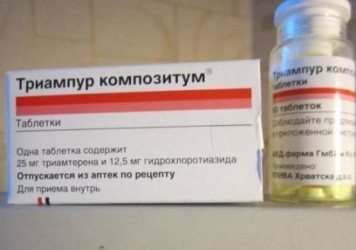
The second group of drugs are nootropic drugs, which are neurometabolic stimulants that have a beneficial effect on higher mental functions. It is recommended to use Cortexin for hydrocephalus, which shows high neuroprotective, antioxidant and nootropic effects. Quite often, Glycinum is prescribed for hydrocephalus, which improves metabolic processes in brain tissue. The treatment program for hydrocephalus often contains a powerful antioxidant, nootropic, stress-protective agent, an inhibitor of free radical compounds - Mexidol (Mexidolum).
The third class of drugs for treating the disease are cerebral circulation correctors. The first choice drug for hydrocephalus is Cavinton. The drug has a dilating effect on the blood vessels of the brain, increases blood circulation, and helps improve the supply of oxygen to tissues.
The treatment program may also include:
- plasma expander solutions;
- glucocorticosteroid drugs;
- non-steroidal anti-inflammatory drugs;
- antimigraine medications;
- barbituric acid derivatives.
Treatment of cerebral hydrocephalus in adults, treatment with folk remedies
Hydrocephalus of the brain is a disease as a result of which fluid accumulates in the cavities, or otherwise ventricles, of the brain. Popularly, this disease is called dropsy of the brain.
The ventricles of the brain significantly increase in size due to the fluid accumulated in them, and the fluid puts pressure on the brain. This pressure can damage brain tissue and prevent it from functioning normally.
This disease can affect a person of any age, but children and the elderly are most often affected. Symptoms of this disease can be different and are determined by the age of the sick person.
- abnormally large head and its constant increase over time
- lethargy
- vomit
- appetite disorders
- irritability
- weak muscle tone
- convulsions
- slow body growth
- increase in head size
- headache
- increase in body temperature
- vomit
- inhibition in speech development
- loss of acquired skills
- vision problems
- irritability
- learning disabilities
- lack of concentration and attentiveness
- appetite disorders
- lethargy
- convulsions
- problems with the transition from sleep to wakefulness and vice versa
- breathing disorder
- headache
- sleep disorders
- visual impairment
- urinary disorders
- deterioration in performance
- problems with performing a job that the person previously handled successfully
With hydrocephalus, it is very important to pay attention to how the patient sleeps. In no case should his head rise too high in comparison with the position of his body. Therefore, you should avoid pillows altogether or sleep on a low pillow.
An adult suffering from hydrocephalus will benefit from various diuretics. Traditional medicine can also come to the rescue. Below are several useful folk recipes for hydrocephalus.
Cornflower is suitable for the treatment of such ailments as hydrocephalus, since it has a diuretic effect. A medicinal infusion is made from it, which anyone can make independently at home as follows:
- take two teaspoons of blue cornflower flowers
- pour the raw material with 250 milliliters of boiling water
- then let the product sit for a while: just when the boiling water cools down, it will be ready
- then strain the cooled infusion and you can start using it
Use the resulting medicinal product in portions of a fifth of a glass three times a day 15 minutes before meals.
Calamus will help you get rid of problems with urination, and will also help strengthen the body as a whole. To make a medicine from this plant, follow these steps:
- take 50 grams of marsh calamus roots
- clean them
- pour the raw material with half a liter of vodka
- leave the mixture to infuse in a dark place
Take the resulting product one dessert spoon three times a day 30 minutes before meals.
Instead of alcohol tincture, you can make a decoction of calamus, for this you need:
- take 15 grams of calamus roots
- pour 0.6 liters of boiling water over the plant
- put the mixture on the fire and cook for a quarter of an hour
This decoction should be taken in the same way as calamus tincture.
In the treatment of hydrocephalus, lemon balm is used to normalize the functioning of the central nervous system, as a sedative, and also as a means of relieving headaches.
A medicinal decoction from this plant is prepared as follows:
- take 15 grams of lemon balm leaves
- pour a glass of boiling water over the raw materials
- wait until the product cools down - by then it will infuse
The resulting decoction should be drunk in portions of one tablespoon three times a day.
You can also prepare an alcohol tincture from lemon balm; it’s quite simple to do:
- take 25 grams of dry leaves of this plant
- pour a glass of alcohol over the raw materials
- leave this mixture to infuse for 14 days in a dark place
- After this period, begin treatment
This medication should be taken in portions of 15 drops three times a day before meals.
A remedy from astragalus can be prepared as follows:
- take one tablespoon of astragalus herb
- fill it with 250 milliliters of boiling water
- after this, cover the container with the medicine with a lid and leave it for three hours in a dark place
The resulting tincture should be drunk one tablespoon three times a day, 30 minutes before meals.
Source: //DriveAuto-Ural.ru/narsredst/lechenie-gidrotsefaliya-golovnogo-mozga-u-vzroslogo-lechenie-narodnymi-sredstvami/
Recommendations for treatment and prevention at home
At the bottom of the article is a selection of drugs to prevent the disease
General description of the disease
This is a disease during which the level of cerebrospinal fluid (or cerebrospinal fluid) in the cranial cavity increases. The popular name is “dropsy of the brain.”
Liquor is a fluid specially produced by the brain that acts as a buffer for the brain. It nourishes it and protects it from mechanical impacts and damage. The norm of cerebrospinal fluid is 150 milliliters (and this entire volume changes completely three times a day).
Causes of hydrocephalus
The accumulation of cerebrospinal fluid in excess amounts occurs for 2 main reasons. The first is an imbalance in the absorption of cerebrospinal fluid, the second is disruptions in the circulation of cerebrospinal fluid.
Reasons for the development of hydrocephalus in children
Before naming the causes of hydrocephalus in children, it is necessary to divide them into three main groups. At different ages, dropsy of the brain is caused by different reasons.
- Hydrocephalus in an unborn child is determined during an ultrasound of the fetus. Basically, hydrocele is caused by defects in the development of the central nervous system of the fetus or due to the presence of intrauterine infections in the mother’s body (herpes, cytomegaly, toxoplasmosis). Therefore, when planning a pregnancy, every woman needs to be tested for these infections and, if necessary, treated. It is extremely rare that hydrocephalus occurs due to genetic failures.
- Hydrocephalus in infants. In 80% of newborns, dropsy occurs due to defects in the development of the brain and spinal cord, which arose against the background of intrauterine infections in the mother. In the remaining 20% of infants, hydrocephalus occurs due to birth injuries. Basically, the risk group includes premature newborns who, after a birth injury, have had an intracerebral or intraventricular effusion of blood accompanied by an inflammatory process in the meninges (meningitis). All this leads to impaired absorption of cerebrospinal fluid. There have also been cases of dropsy in infants with tumors or vascular defects in brain development.
- Hydrocephalus in children from 1 year to children of the older age group. The disease can be triggered by infectious diseases, encephalitis, meningitis, abnormalities in brain development, hemorrhages, and traumatic brain injuries.
Causes of hydrocephalus in adults
Most people think that hydrocephalus only affects newborns and children. But in reality this is not true. Dropsy of the brain can also develop in adulthood. Basically, this disease develops due to high pressure on certain areas of the brain. Such compression can begin due to previous meningitis, meningoencephalitis, serious poisoning, severe head injuries, stroke, syphilis, due to the development of tumors: ependyoma, medulloblastoma, chronic circulatory failure in the brain, due to ongoing infectious processes in the nervous system. system.
Forms of hydrocephalus
Hydrocephalus is divided into groups depending on its origin, etiology, and course.
Depending on when the disease occurred, hydrocephalus is divided into congenital and acquired . Congenital dropsy of the brain developed before the birth of the child, and acquired, naturally, after the baby was born.
In turn, acquired hydrocephalus is divided into closed, open and hypersecretory hydrocephalus . This classification is based on the origin of the disease.
Closed (occlusive) hydrocele of the brain. In this case, the outflow of cerebrospinal fluid is impaired due to the fact that the passage through which cerebrospinal fluid flows is closed.
Open (communicating) hydrocephalus. The absorption of cerebrospinal fluid is impaired due to damage to the structures involved in the absorption process.
Hypersecretory hydrocele of the brain develops against the background of abnormally high production of cerebrospinal fluid.
Depending on the course, the disease is divided into 3 forms:
- acute (3 days passed from the first symptoms to complete disruption of the outflow of cerebrospinal fluid);
- subacute (after the onset of hydrocephalus, 30 days pass before severe decompensation);
- chronic (the disease develops slowly - from 21 days to six months).
Symptoms of hydrocephalus
The manifestations of hydrocephalus also depend on age.
Signs of hydrocephalus in newborns
In most cases, children are born with normal head volume or with slight increases in volume. The head begins to increase in size in the first or second month of the baby’s life. It is during this period that the head actively grows.
How much the head will increase in size depends on the indicators of intracranial pressure.
During a visual examination, it is necessary to examine the hairline (it will be sparse), the cranial sutures (their divergence will be visible), the fontanelles (they will be tense and bulging), the forehead (a disproportion will be observed: the frontal arches will be very large and the forehead will be excessively convex).
Also, you should pay attention to the bones of the skull - they will be thinned.
Signs of hydrocephalus in children
With the further development of the disease, the child’s weight begins to decrease, while the muscle tone of the arms and legs greatly increases.
Also, marbled skin is observed (the venous pattern is clearly visible), nystagmus and strabismus (the child’s eyes constantly “run around”, he cannot focus them on any one object), the baby burps very often, his level of hearing decreases, he becomes restless, whiny or, conversely, lethargic, drowsy, lethargic.
In addition, there are delays in the child's development. This concerns the development of speech, motor skills, and psyche.
Myths in diagnosing increased intracranial pressure in children
If a child has disturbances in behavior, sleep, excessive activity, inattention, increased tone of the lower extremities, trembling chin, walking on toes, and even a marbled skin pattern, this does not mean that the child has increased intracranial pressure. Based on these signs, a diagnosis of hydrocephalus cannot be made. In addition to the above symptoms, the head should be enlarged, the fontanelle should be enlarged, and other symptoms for newborns and children should be present.
To diagnose “hypertensive-hydrocephalic syndrome” or “intracranial hypertension” you need to undergo MRI (magnetic resonance imaging), NSG (neurosonography), CT (computed tomography).
Signs of hydrocephalus in adults: nausea, vomiting, headache (mainly in the morning), dizziness, ophthalmological changes, drowsiness, hearing problems. It is worth noting that after the patient vomits, he feels much better.
Traditional methods of helping with hydrocephalus
A disease characterized by the accumulation of fluid in the ventricles of the brain is called hydrocephalus or dropsy of the brain. As a result of the accumulation of fluid, a significant increase in the size of the brain cavities occurs. Moreover, this excess fluid puts a lot of pressure on the brain.
Pressure can cause damage to brain tissue and also impair brain function. The disease can occur in anyone.
However, hydrocephalus is more common in children and the elderly.
The main manifestations of the disease include: an increase in the size of the head, vomiting, nausea, weakening of muscle tone, the appearance of seizures, increased irritability, loss of appetite, and slower growth.
Alternative medicine in the fight against hydrocephalus
With this pathology, the patient should pay special attention to his sleep and nutrition. People with hydrocephalus are recommended to sleep either on a very low pillow or without one at all. The head should not be higher than the position of the body.
As for nutrition, it is advisable for patients to eat foods of plant origin. The diet should include cabbage, cucumbers, zucchini, honey, parsley. But you should be careful with salt. The use of this product should be either minimized or completely eliminated.
Diuretics occupy a special place in the treatment of the disease. Celery, currants, and watermelon have an excellent diuretic effect.
Recipes for traditional medicines that promote the treatment of hydrocephalus
Radish in the fight against illness. Take a couple of black radish fruits, peel them, cut them into cubes and squeeze out the juice. Take 70 ml of the drug twice a day. It is better to add a little honey to the juice.
Application of onion juice. Take several medium-sized onions, chop and add sugar. This should be done in the evening so that the onions release their juice at night. In the morning, place the mixture on gauze folded in three layers and squeeze out the juice. Drink 10 ml of juice daily on an empty stomach.
Pumpkin juice helps cure illness. It is recommended to drink 100 ml of freshly squeezed juice twice a day.
Therapy of hydrocephalus with grapes. Eating fresh grapes helps treat the disease. Just eat about 10 grapes in the morning on an empty stomach. It is advisable not to eat anything for at least an hour after eating grapes.
Elderberry treatment
Use of elderberry decoction. In the early stages of the disease, a decoction of the plant bark is quite effective. Take 10 grams of raw material, grind it and add 500 ml of water. Place the container on the stove, bring the mixture to a boil, then reduce the heat and simmer for another quarter of an hour. Remove the container from the stove and put it in a warm place for several hours. Drink 100 ml of the drug five times a day.
Elderberry tincture in the treatment of dropsy of the brain. Take the dried rhizome of the plant, chop it finely and pour 30 grams of raw material into a glass liter bottle.
Fill the container to the top with medical alcohol or vodka. Place the container in a cool, dark place for two weeks.
Filter and consume 20 drops of medicine diluted in half a glass of boiled, slightly cooled water once a day.
Parsley in the treatment of dropsy of the brain
- Pour 500 grams of fresh herbs with milk, about 800 grams. Place the container with the composition in a preheated oven and leave to simmer for a couple of hours. There is no need to bring the milk to a boil. Filter the product and consume 15 ml of the drug every two hours.
- Parsley infusion will help in treating the disease.
Chop the parsley and steam the raw material in half a liter of boiled water. Place the container in a dry, warm room for 10 hours. Then filter the product and combine with 15 ml of lemon juice. Take 150 of the drug three times a day.
Treatment with lemon balm
Preparation of lemon balm decoction. This medicine helps to normalize the functioning of the central nervous system, as well as eliminate headaches. Steam approximately 20 g of dried crushed plant leaves with 300 ml of boiling water. Let the product sit a little. Take 10 ml of the drug twice a day.
Melissa tincture is an ideal remedy for treating dropsy of the brain. Place 30 grams of dry, finely chopped leaves of the plant into a glass container and fill a glass with medical alcohol. Place the composition in a cool, dark room for fifteen days. Filter and consume 30 drops of tincture diluted in a glass of warm water twice a day.
Folk remedies and medicinal plants used in the treatment of headaches.
7. Black elderberry (flowers)
Infusion; 1 tbsp. spoon of raw materials per 1 cup of boiling water, leave for 20 minutes, strain. Take 0.25 cups 3-4 times a day 15 minutes before meals.
8. Valerian officinalis (roots)
Infusion: 1 tbsp. spoon of raw materials per 1 glass of cold boiled water, leave for 6-8 hours, strain. Take 1 tbsp. spoon 3 times a day.
Valerian can also be taken in the form of a decoction. The effectiveness of valerian appears to be higher with systematic, long-term use.
9. Sparrow officinalis (herb)
Infusion: 1 tbsp. spoon of raw materials per 1 cup of boiling water, leave for 2 hours, strain. Take 0.25 cups 3-4 times a day.
10. Elecampane tall (roots)
Infusion: 1 tbsp. spoon of raw materials per 1 glass of cold boiled water, leave for 10 hours, strain. Take 0.25 cups 4 times a day half an hour before meals.
11. Oregano (herb)
Infusion: 1 tbsp.
spoon of raw materials in 0.5 liters of boiling water, leave, covered, 10 minutes, strain. Take 0.5-4 glasses 2-3 times a day. Pregnant women should not take oregano infusion.
12. St. John's wort (herb)
Decoction: 1 tbsp. spoon of raw material in 1 glass of water, boil for 15 minutes, cool, strain. Take 0.25 cups 3 times a day.
13. Prince Siberian (leaves)
Decoction: 1 tbsp. spoon of raw material in 1 glass of water, boil for 15 minutes, cool, strain. Take 3 times a day.
14. Linden cordifolia (flowers)
Infusion: 1 tbsp. spoon of raw materials per 1 cup of boiling water, leave for 30 minutes, strain. Drink like tea.
15. Coltsfoot (leaves)
Infusion: 1 tbsp. spoon of raw materials per 1 cup of boiling water, leave for 30 minutes, strain. Take 1 tbsp. spoon 4-6 times a day an hour before meals.
16. Melissa officinalis (herb)
Infusion: 1 tbsp. spoon of raw materials per 1 cup of boiling water, leave, covered, 30 minutes, strain. Take 3 times a day.
17. Peppermint (herb)
Decoction: 1 teaspoon of raw material per 1 glass of water, boil over low heat for 15 minutes (with frequent stirring), cool for 45 minutes, strain. Take warm, 0.3-0.5 cups 1-3 times a day, 15 minutes before meals.
18. Wormwood (leaves)
Infusion: 1 teaspoon of raw material per 1 glass of boiling water, leave for 3-4 hours. Drink 0.3 glasses 3 times a day.
19. Primrose (roots, stems, leaves)
Infusion: 1 teaspoon of raw material per 1 glass of boiling water, leave for 30 minutes, strain.
Take 0.5 cups 2 times a day. The infusion has a mild hypnotic effect and helps with excessive excitement.
20. Opened lumbago (grass)
Infusion: 2 teaspoons of raw material per glass of cold boiled water, leave for 24 hours. Take 0.25 cups 4 times a day, cold.
21. Common thyme (leaves and flowers)
Infusion: 1 tbsp. spoon of raw materials per 1 cup of boiling water, leave for 30 minutes, strain. Take hot 3 times a day.
22. Dill (seeds)
Infusion: 1 tbsp. spoon of raw materials per 1.5 cups of boiling water, insisted! 30 minutes, strain. Take 0.3 cups 4 times a day.
Traditional recipes for the treatment and relief of headaches.
1. For headaches from mental fatigue, it is useful to take a warm bath or at least immerse your feet up to the ankles in hot water for 10-15 minutes. It is also good to drink a glass of hot peppermint infusion.
2. For colds and runny nose with headache, lubricate the forehead, temples, behind the ears, and the back of the head with menthol oil. This is good for relieving headaches at the onset of the disease.
3. For severe headaches, smear the forehead and temples with grated lemon pulp and peel or apply lemon circles to the temples, which are not removed until the headache passes.
4. During a migraine attack, painkillers and sleeping pills are recommended. Some people find hot foot baths, sometimes hot compresses on the head, squeezing the head tightly, and hot drinks helpful. It is advisable to cleanse the intestines.
5. Massage the head, starting from the forehead and moving both hands to the back of the head.
6. Inhale a mixture of equal parts of camphor alcohol and ammonia.
7. Chronic pain of nervous origin indicates extreme general nervousness of the patient. He needs rest, peace, and restoratives.
9. Applying a mixture of sour dough, soap, rue and vinegar will also help.
10. For periodic pain in the back of the head, it is recommended to tilt your head down and lift it up 2-3 times, turn to the left and right shoulder in turn 2-3 times, then, relaxing all the ligaments of the neck, make a circular movement with your head in one direction or the other side. Perform this exercise several times in a row, and then, if the pain does not calm down, repeat after a while.
Chronic headaches will help you recover from this illness in combination with medications prescribed by your doctor. Headache is often the cause of dizziness. Get to know the symptoms, prevention and read about the most common diseases.
Hydrocephalus is a pathological condition that occurs when there is excessive accumulation of cerebrospinal fluid in the cranial cavity. If the disease is untimely or incorrectly treated, it can give rise to global damage to brain structures and cause death. curable!
Types and symptoms of the disease
So, as for the symptoms, let’s consider the most common ones, which often require treatment, these include:
- Severe headaches, a feeling of heaviness, especially often in the morning.
- Nausea accompanied by vomiting in the morning is the most obvious symptom of hydrocephalus, when all other causes of this condition are excluded.
- Signs of VSD: rapid heartbeat, sweating, increase or decrease in blood pressure, etc.
- Severe fatigue.
- Increased nervousness and headaches - these two inseparable symptoms of hydrocephalus are characteristic of both children and adults. Their treatment is usually started first.
- Impotence is observed.
- Increased intracranial pressure.
If you experience similar symptoms, you should immediately consult a doctor in order to promptly identify and begin treatment for hydrocephalus at home or in a hospital, depending on the form.
Treatment with simple folk remedies is in great demand. There are different forms of it in case of excess fluid production, impaired outflow due to tumors, adhesions after inflammatory diseases. This condition has certain symptoms. These are signs of hydrocephalus and increased intracranial pressure: headache, nausea, vomiting. Sometimes, without treatment, signs of damage to the nervous system appear, such as impaired hearing, vision, etc.
Forms of hydrocephalus
This disease is divided into acute and chronic. The acute form of hydrocephalus manifests itself at the onset of the disease, and the chronic form occurs when the acute form is untreated. There are cases of intrauterine onset of the disease - in this case, the diagnosis sounds like this - congenital hydrocephalus - the most common type. With this pathology, children are born with abnormal head sizes of up to 70 cm in circumference, versus 34 normally. The head changes shape with hydrocephalus - it becomes spherical, the forehead protrudes forward. All cranial sutures separate. The fontanelles bulge. Treatment of a disease such as hydrocephalus with natural alternative medicine can be used along with conventional treatment. But surgical intervention is usually not possible.
With hydrocephalus in any form, there is a delay in the child's development. With this pathology, they begin to hold their head up later, as well as sit and walk; there will be muscle weakness (more on the legs). Visual acuity decreases without treatment, and epileptic seizures sometimes occur. When the sutures are closed, another symptomatology appears - now the skull is tightly closed, its volume cannot be changed, and symptoms that occur when there is pressure on the brain begin. These are headaches, vomiting, symptoms caused by damage specifically to one or another area of the brain.
